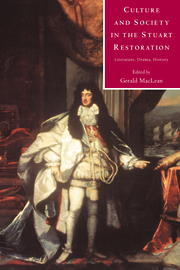Book contents
- Frontmatter
- Contents
- Notes on contributors
- Acknowledgments
- Abbreviations and note on the text
- INTRODUCTION
- PART I DRAMA AND POLITICS
- PART II AUTHORSHIP AND AUTHORITY
- PART III WOMEN AND WRITING
- PART IV EMPIRE AND AFTERMATHS
- 11 Seventeenth-century Quaker women: displacement, colonialism, and anti-slavery discourse
- 12 Republicanism, absolutism and universal monarchy: English popular sentiment during the third Dutch war
- 13 Reinterpreting the “Glorious Revolution”: Catharine Macaulay and radical response
- Index
13 - Reinterpreting the “Glorious Revolution”: Catharine Macaulay and radical response
Published online by Cambridge University Press: 20 August 2009
- Frontmatter
- Contents
- Notes on contributors
- Acknowledgments
- Abbreviations and note on the text
- INTRODUCTION
- PART I DRAMA AND POLITICS
- PART II AUTHORSHIP AND AUTHORITY
- PART III WOMEN AND WRITING
- PART IV EMPIRE AND AFTERMATHS
- 11 Seventeenth-century Quaker women: displacement, colonialism, and anti-slavery discourse
- 12 Republicanism, absolutism and universal monarchy: English popular sentiment during the third Dutch war
- 13 Reinterpreting the “Glorious Revolution”: Catharine Macaulay and radical response
- Index
Summary
As a republican historian who deliberately focused on the seventeenth century because of what she saw as its relevance to her time, Catharine Macaulay (1731–91) provides a link between the seventeenth and eighteenth centuries. Her interpretations of the events of the 1640s and 1650s, the Restoration and the Revolution of 1688–89, not only influenced English radicalism profoundly but also contributed substantially to American and French revolutionary ideology. Above all her rejection of earlier interpretations of the “Glorious Revolution” was crucial to the reshaping of eighteenth-century radicalism. Caroline Robbins distinguished three generations of Commonwealthmen or Real Whigs from the Revolution of 1688 to the end of the eighteenth century. Only the last, “the third generation of the age of the American Revolution,” was she prepared to call “early radicals.” It is with this group that Macaulay most closely identified and it is with her response to the “Glorious Revolution” that I am mainly concerned. Throughout the century the Revolution remained crucial to all political discussion. “No major debate involving any discussion of fundamental political principles took place,” writes H. T. Dickinson, “without the events of 1688–89 being used as a source of inspiration and guidance.” It had a shaping influence on all eighteenth-century politics.
The debate over whether the Revolution of 1688–89 was of more long-term significance than that of the 1640s is not one I intend to enter.
- Type
- Chapter
- Information
- Culture and Society in the Stuart RestorationLiterature, Drama, History, pp. 267 - 285Publisher: Cambridge University PressPrint publication year: 1995
- 1
- Cited by



